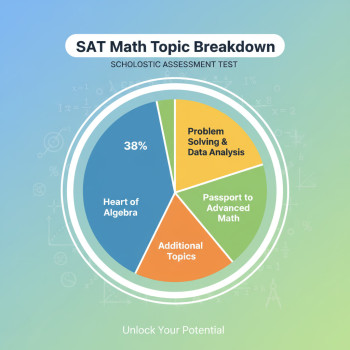Why talk about the Digital SAT when admissions are ‘holistic’?
College admissions have evolved. Many universities emphasize holistic review—meaning they look at the whole person, not just a single number. Yet the Digital SAT still plays an important role for many applicants. If you’re a student or a parent feeling puzzled about where the test fits into the big picture, this blog is for you: clear, practical, and written like a conversation over coffee.

Short answer: the SAT is a piece of the puzzle, not the whole puzzle
Think of an application as a layered portrait. Your GPA, classes, essays, recommendation letters, extracurriculars, and background paint the face. The Digital SAT adds texture—evidence of certain academic skills under time pressure. Admissions officers use SAT scores to compare preparedness, identify applicants for scholarships or honors programs, and sometimes to place students in first-year courses. But scores rarely, if ever, tell the whole story.
What does the Digital SAT actually measure?
The Digital SAT focuses on skills colleges care about: reading with comprehension, reasoning with evidence, and math fluency including problem solving and modeling. Because it’s delivered digitally, test experience has shifted—timing structure, on-screen tools, and question formats are different from the paper test you might remember. Importantly, the test measures how well a student applies core skills, not how many facts they’ve memorized.
How to translate scores into meaning
Instead of obsessing over a single target, think in bands: where do your scores suggest strengths (for example, quantitative reasoning) and where do they show growth opportunity (for example, data interpretation or time management)? Use those patterns to prioritize practice rather than chasing a perfect number.
Holistic admissions: what are admissions offices really looking for?
“Holistic” isn’t mystical. It’s a deliberate process admissions teams use to balance academic readiness with context. They ask: What did this student do with the opportunities available to them? How have they challenged themselves? Do their interests and achievements suggest they’ll contribute to campus life and succeed academically?
Key pieces of a holistic file
- Academic transcript (course rigor and GPA)
- Standardized test scores (if submitted)
- Personal essays and supplemental writing
- Letters of recommendation
- Extracurricular involvement and leadership
- Contextual factors (school profile, family background, life challenges)
How admissions officers use the Digital SAT alongside other materials
Admissions committees weave SAT results into the broader narrative. Here are common ways they use scores:
- Confirming academic readiness: Do the scores align with a student’s transcript?
- Comparative tool: SATs provide a common data point for students from different schools and curricula.
- Placement & scholarships: Many colleges use scores to place students in courses or award merit aid.
- Addressing gaps: A strong score can reassure committees if a transcript has unusual dips; a low score can be contextualized by other strengths.
Example scenarios
Imagine two applicants with similar GPAs. One’s SAT score is clearly above average for a given program—this could push their file into a more competitive pile. Alternatively, an applicant with a modest score but a powerful research project or sustained leadership may still shine because their record demonstrates qualities that scores don’t measure.
Should you submit scores? Strategies for test-optional and test-informed policies
Many colleges are test-optional or test-informed today, which means policies vary: some schools will consider scores if submitted, others won’t require them but may use them for course placement or scholarships. If you’re deciding whether to submit a score, weigh these factors:
- How your score compares to the middle 50% at your target schools.
- Whether your transcript and essays already convey academic strength.
- If submitting a score could help with scholarships or honors programs.
- Whether you have a compelling context that explains any lower scores (illness, disruptions, etc.).
Quick decision guide
| Situation | Recommended Action |
|---|---|
| Score above or near target school’s middle 50% | Submit—can strengthen application and aid consideration for scholarships. |
| Score below school’s middle 50%, but strong transcript/essays | Consider not submitting unless required; provide context in optional statement if relevant. |
| Applying to merit-based scholarships | Submit if score meets scholarship thresholds—can be decisive. |
| Score is close but could improve with focused prep | Retake after targeted study; use practice diagnostics to guide preparation. |
How to prepare in a way that respects the larger application
Preparation shouldn’t be about cramming a month before the test; it should integrate with the academic year and your broader growth. Here’s a sensible, student-friendly plan:
- Start with a diagnostic to identify weak areas—don’t guess where you’re weak.
- Create a realistic schedule that balances schoolwork, activities, and test prep.
- Focus on high-leverage skills: evidence-based reading, data interpretation, algebra and modeling, and clear problem set strategies.
- Use practice tests under realistic timing to build stamina and pacing.
- Review errors carefully—understanding why you missed a question is more valuable than sheer repetition.
Practical tip: quality beats quantity
Two hours of focused study with deliberate practice beats five hours of passive review. Try short, focused sessions (40–60 minutes) with clear goals: learn a strategy, apply it to practice, review mistakes, and write a short summary of the lesson.
When personalized help makes a difference
Everyone has different patterns of strengths and friction. Some students need help with timing, others with reading dense passages, and others with choosing the right math model quickly. This is where personalized tutoring shines: a tutor can create a study plan that targets the exact skills that matter for raising your score while keeping your schedule and stress levels in mind.
Sparkl’s role—how personalized tutoring fits naturally
Personalized tutoring—like the tailored approach Sparkl offers—can be especially useful if you need one-on-one guidance, a study plan aligned to your school calendar, or nuanced feedback on test-taking habits. Expert tutors can translate practice-test patterns into targeted strategies, and AI-driven insights can highlight subtle trends in timing and question types so you make faster progress. When tutoring fits your learning style, it helps your entire application by freeing up time to focus on essays and activities while steadily improving scores.
Balancing test prep with the rest of the application
Don’t let SAT prep eclipse the rest of your story. Colleges want engaged, multifaceted applicants. Carve time for subject mastery, meaningful extracurriculars, and thoughtful essay writing. A strong score is valuable, but it should complement—not replace—the parts of your application that show character, curiosity, and commitment.
Time allocation example (weekly)
- Schoolwork and homework: 50–60% of focused study time
- SAT practice (during active prep months): 15–25%
- Extracurriculars/projects: 10–20% (depth over breadth)
- College research & essays: 10–15% (intensify in senior year)
Putting scores in context: stories that resonate with admissions
Admissions officers read thousands of files and appreciate context. Here are a few illustrative vignettes that show how scores interact with the rest of the application:
- A student with a 3.9 GPA, powerful theme-driven essays about caring for a sibling, and a SAT score slightly below the school’s median—admissions sees commitment and maturity; a lower score is informative but not disqualifying.
- An applicant with strong STEM coursework, a project that led to local recognition, and a SAT score above the program’s median—this combination suggests readiness for rigorous majors and can bolster scholarship consideration.
- A student from a small school with limited AP options but a strong upward trajectory and competitive SAT performance—scores help compare academic readiness across different school contexts.
How to present your test story in applications
If there are special circumstances—illness, disruption, or an otherwise nontraditional path—use optional sections or your counselor letter to explain briefly and clearly. If you chose not to submit scores, let other parts of your application shine: stronger essays, recommendations, and documentation of academic engagement.
Dos and don’ts when addressing test scores
- Do be concise and factual if you explain circumstances.
- Don’t make excuses—focus on what you learned or how you responded.
- Do submit scores if they clearly strengthen your case (scholarships, program cutoffs).
- Don’t overemphasize a single measure—connect it to your broader narrative.
Real-world comparisons: SAT scores vs. holistic proof
Imagine two applicants in an engineering program pool. One has a high SAT math score but less project experience; the other has slightly lower scores but two years of robotics leadership and a community STEM internship. Admissions officers will weigh both: quantitative readiness matters, but demonstrated engagement and hands-on experience often tip the balance toward the student who has already shown what they’ll do with an education.
Data presentation: hypothetical score bands and application fit
| Score Band (Total) | Typical Interpretation | Application Strategy |
|---|---|---|
| Top percentile | Strong academic indicator | Submit for scholarships and honors; highlight leadership. |
| Above average | Confirms readiness | Submit where helpful; focus essays on fit and contribution. |
| Average | Helpful but not decisive | Use other strengths (research, leadership) to stand out. |
| Below average | Can be contextualized with strong non-test evidence | Consider not submitting unless required; explain context if needed. |
Practical next steps for students and parents
If you’re in the middle of planning, here’s a clear checklist to move forward confidently:
- Take a diagnostic Digital SAT to identify strengths and gaps.
- Create a study rhythm—short, deliberate sessions over months beat last-minute cramming.
- Decide which schools you’ll apply to and check their test policies and scholarship requirements.
- Consider targeted, personalized tutoring if you need structure or help with stubborn problem areas—one-on-one guidance can accelerate progress and reduce stress.
- Balance test prep with essays, recommendations, and meaningful extracurriculars that tell your story.
How parents can help without taking over
- Encourage consistent study habits and emotional support.
- Help student research test policies for target schools, but let the student lead decisions.
- Provide logistics support—test registration, quiet study space, and a calm morning on test day.
Final thoughts: scores matter, but so does the person behind them
The Digital SAT is a meaningful academic signal, but in holistic admissions it’s one of several signals. What admissions officers most want is evidence that you’ll thrive academically and contribute to campus community. The best strategy is balanced: prepare intelligently for the SAT, but also invest in essays, projects, and experiences that reveal who you are.

If you find targeted guidance helpful, consider a personalized tutoring approach—like Sparkl’s—where one-on-one tutors create tailored study plans, provide skill-focused instruction, and use insights to track progress so you spend time where it matters most. That way, test prep becomes a complement to building a compelling application, not a competing priority.
Parting encouragement
College admissions can feel complicated and high-stakes, but remember: admissions offices look for authenticity, curiosity, and growth. The Digital SAT can open doors, but it won’t define you. Prepare thoughtfully, tell your story well, and let your strengths—on the page and in person—shine through.
Good luck. Take a breath, make a plan, and move forward one deliberate step at a time.


















No Comments
Leave a comment Cancel